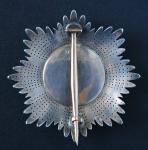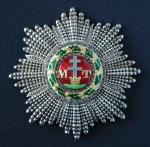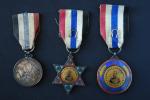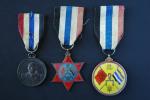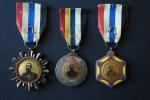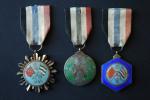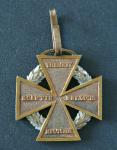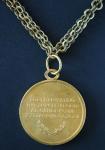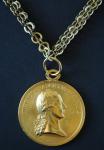-
Posts
1,161 -
Joined
-
Last visited
-
Days Won
17
Content Type
Profiles
Forums
Blogs
Gallery
Events
Store
Everything posted by Elmar Lang
-
Hello, this St.Stephen's-like cross is not exactly a fantasy order, but it's the Knight's Cross of the "Ungarisches adeliges Kapitel-Kreuz", or "Chapter's Cross of the Hungarian Nobility"; an association of Hungarian nobles, founded in Luzern (Switzerland), on 19. September 1960. The decoration was awarded depending on the title's level; in other words, the Knight's Cross was intended to the lower grades of nobility, patrices with coat-of-arms and "Vit?z". The small "defect" we see on the left side of the crown suspension, is an evidence that the piece was produced by Rothe & Neffe, Vienna. The plain reverse medallion was engraved with a progressive number. The obverse medallion, although not enamelled, resembles that of the "Magyar Erdemrend", or Hungarian Merit Order, from the Horthy period, 1922-1944, not that of the Order of the Sacred Crown. The ribbon is also correct. More info about this private decoration can be found on Prochazka, II Edition, Vol. 4, pages 258-259. Best wishes, Enzo
-

Austria-Hungary The Order of St. Stephen
Elmar Lang replied to Elmar Lang's topic in Austro-Hungarian Empire
-

Austria-Hungary The Order of St. Stephen
Elmar Lang replied to Elmar Lang's topic in Austro-Hungarian Empire
...and here are two Grand Cross sets. The first, with the badge of early manufacture, re-issued with the upgraded suspension, made with old uniface crown adapted with a ribbon ring; the second, belonged to Cardinal Giuseppe Taliani is from the late XIX Century. -

Austria-Hungary The Order of St. Stephen
Elmar Lang replied to Elmar Lang's topic in Austro-Hungarian Empire
...it seems that I still need to learn how to resize pictures. My sincere apologies, Enzo -

Austria-Hungary The Order of St. Stephen
Elmar Lang replied to Elmar Lang's topic in Austro-Hungarian Empire
-

Austria-Hungary The Order of St. Stephen
Elmar Lang replied to Elmar Lang's topic in Austro-Hungarian Empire
-
Hello, I would like to start a discussion about this high Austro-Hungarian Order, beginning with a curious piece: a Grand Cross breast star of British manufacture. The diameter is 7,1 cm., quite smaller than usual; the short "flamed" rays are gilt. The pin is made of gold and on the reverse medallion there is the engraved mark of "Wm. Gray Jeweller 13. New Bond St.". I know that collectors like "official pieces" more than such foreign-made pieces, but I find this star and highly attractive. Best wishes, Enzo Obverse side:
-
Thank you very much Ed, I'll check the ANS-Auction Catalogue from M&E carefully. ...I've forgot to search through the OMSA database... thank you for remembering. Best regards, Enzo
-
Thank you Hugh. I agree, or Chinese 1st Republic. Let's see if other colleagues would find further details. Kind regards, Enzo
-
-
-
-
Hello, I've received these 6 chinese pieces but, besides some vague idea, I cannot identify them properly. I'm sure in the knowledge of our Forum's colleagues. Many thanks in advance, Enzo
-

Austria-Hungary A never-introduced Cannon Cross, 1813
Elmar Lang replied to Elmar Lang's topic in Austro-Hungarian Empire
Well... I'm glad that the style of my pictures would have some "Victorian" taste! Enzo -

Austria-Hungary A never-introduced Cannon Cross, 1813
Elmar Lang replied to Elmar Lang's topic in Austro-Hungarian Empire
Pity there wasn't any description of the cross' condition in v. Heyden's auction catalogue; in the Julius one, the piece was described as "sehr sch?n"... The same I could dare to say now, after the many years since it became part of my collection. I hope I'll be in good shape and health, in 2119... but what's going to happen, then? An anniversary? The Final Judgement?... Just asking, because I would like that nothing wrong would happen to my little Cannon Cross prototype! Best wishes, Enzo -

Austria-Hungary A never-introduced Cannon Cross, 1813
Elmar Lang replied to Elmar Lang's topic in Austro-Hungarian Empire
Hello, Prochazka ("Oesterreichisches Ordenshandbuch", 2nd edition, vol. 2, pages 61-62) describes the Kanonenkreuz under no. 312. It is the piece awarded to all the Austrian military involved in the "Befreiungskriege" against Napoleon. No. 313 is the piece especially awarded to Karl, prince Schwarzenberg (the piece is on display at the Austrian Army Historical Museum in Vienna); the size is 50 x 45 mm., larger than the piece in this discussion. No. 313a is the piece here shown. Prochazka thinks that it could have been a never introduced "Cannon Cross for higher-ranking officers". The author repeated in his book the mistake reported both in the first Julius auction Catalogue (Otto Helbing, M?nchen, 1926, page 280, lot 3620) and in the definitive one (M?nzhandlung R. Gaettens, Heidelberg: "Sammlung Julius - Franz?sische Revolution - Napoleon I. und seine Zeit... II. Teil 1809-1815" 14 - 16 September 1959, page 41, lot 3540. By the way, this lot, with an estimation of 40,- German Marks, was sold for 30,-...), where the cross was described with almost the same words then used by Prochazka. It seems that he didn't pay attention to both v. Heyden's book and to his description in the catalogue where the collector put his decorations for sale (in the v. Heyden auction, 1898, the piece was sold for 20,- Reichsmark). Now, we see once more, what a wrong auction catalogue's description could do... The fact that the piece is entirely hand-made and not struck, allows us to confirm the thought of other authors stating that it is the prototype of what -later- became the Kanonenkreuz. Noteworthy, the piece bears the year 1813 only, instead of the definitive 1813-1814. I've forgot to mention that this piece was also studied -and published- by V?clav Měřička in the early '70s in a Czechoslovakian Numismatic bulletin (pages 23-31: "Zaj?mavosti o dělov?m Kř??i a občansk?m kř??i z let 1813 a 1814"). This cross, is an historical curiosity, and we should consider it under this point of view, besides its rarity (or uniqueness). Best wishes, Enzo -

Austria-Hungary A never-introduced Cannon Cross, 1813
Elmar Lang replied to Elmar Lang's topic in Austro-Hungarian Empire
-
Hello, I think that it could be interesting to add the history of a well-known Austrian decoration from the Napoleonic wars with a relatively less known detail: the first model, prepared by the "Kammer-Medailleur" Harnisch of the famous "Metallenes Armeekreuz", also known as "Kanonenkreuz", or "Cannon Cross". The piece described hereby, belonged to the von Heyden Collection, reported in his book "Ehren-Zeichen der erloschenen und bl?henden Staaten Deutschlands und Oesterreich-Ungarns", Meiningen, 1897 under nr. 1009, ?Kanonen-Kreuz pro 1813. Modell". In 1898, when von Heyden let his collection be auctioned (?Sammlung v. Heyden. Ehrenzeichen ? Deutschlands und Oesterreichs-Ungarns. Versteigerung am 19. Oktober 1898", Adolph E. Cahn, Frankfurt), the piece appears as lot n. 860 ?Probe eines Kanonenkreuzes pro 1813. Bronze. Wohl Unicum.". After the auction, it entered in the Julius collection, then sold again when the Julius Collection was auctioned in 1959. In the Gaettens auction catalogue (lot 3540), the piece was wrongly described as "Oesterreichisches Kanonenkreuz f?r H?here Offiziere?", while other details, such as the silvered laurel wreath and measures appear correctly reported. This interesting decoration was also published from the late Prof. Fattovich in the n. 5 (1969) of the Bulletin of the Austrian Numismatic Society. In the Austrian Army Museum should also exist an ancient copy (made of tin alloy) of the two sides of this cross, although I don't remember it on display. The actual piece is made of a reddish bronze alloy and, examining it with a lupe, it clearly appears as being entirely chased by hand. The laurel leaves are sculpted with the utmost care and silvered. The size of the cross is mm 42 x 39 (excluding the ribbon ring). Best wishes, Enzo
-

Austria-Hungary An Austro-British medal
Elmar Lang replied to Elmar Lang's topic in Austro-Hungarian Empire
Hello, the signature under the Emperor's Bust is "I.N.WIRT.F." or Iohann Nepomuk Wirt Fecit. I think that wearing the piece under one's shirt could be quite uncomfortable... Now, let's find the other 7 pieces! Best wishes, Enzo -

Austria-Hungary An Austro-British medal
Elmar Lang replied to Elmar Lang's topic in Austro-Hungarian Empire
-

Austria-Hungary An Austro-British medal
Elmar Lang replied to Elmar Lang's topic in Austro-Hungarian Empire
-

Austria-Hungary An Austro-British medal
Elmar Lang replied to Elmar Lang's topic in Austro-Hungarian Empire
Reverse side: Villiers2b.pdf -

Austria-Hungary An Austro-British medal
Elmar Lang replied to Elmar Lang's topic in Austro-Hungarian Empire
Hello, many thanks for the precious information given to better study this particular, Austrian medal. As promised, I post the pictures of the obverse and reverse side of it, where the S-Shaped links of the collar chain are well visible. I wasn't able to resize it, so I'm posting a .pdf file. Best wishes, Enzo Villiers2a.pdf -

Austria-Hungary Order of Maximilianus ?
Elmar Lang replied to Greg's topic in Austro-Hungarian Empire
Hello, I agree with Vaughan. Both the medal and the badge should be commemorative pieces to Emperor Maximillian. In any case they aren't official decorations. Best wishes, Enzo -

Austria-Hungary About The St.Stephan Breast Star
Elmar Lang replied to avsaribar's topic in Austro-Hungarian Empire
Hello, I've seen original breast stars of the St. Stephen's order either bearing hallmarks or not. Most of them have the marks of Rothe on the pin and on the reverse centre medallion; if the piece was made after 1867, it should also be struck with the silver assay marks. A picture of the piece would help a lot to give a more exact opinion. Best wishes, Elmar Lang





